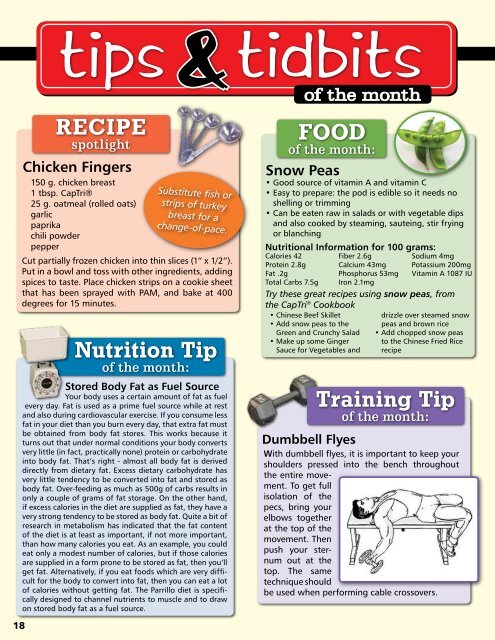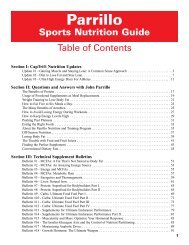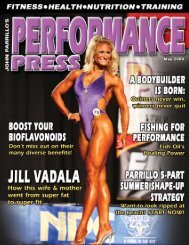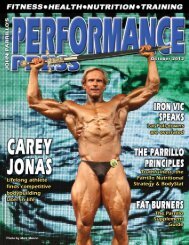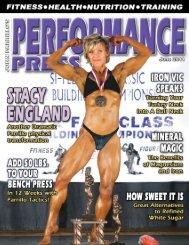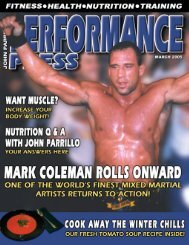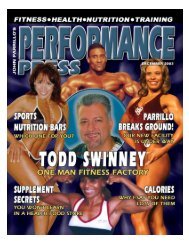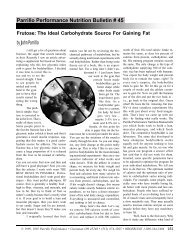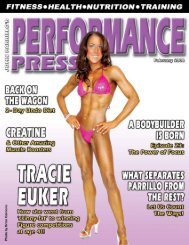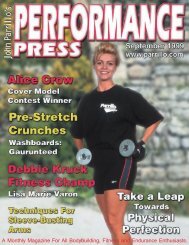You also want an ePaper? Increase the reach of your titles
YUMPU automatically turns print PDFs into web optimized ePapers that Google loves.
tips<br />
RECIPE<br />
spotlight<br />
Chicken Fingers<br />
150 g. chicken breast<br />
1 tbsp. CapTri®<br />
25 g. oatmeal (rolled oats)<br />
garlic<br />
paprika<br />
chili powder<br />
pepper<br />
nutrition Tip<br />
of the month:<br />
& tidbits<br />
Substitute fish or<br />
strips of turkey<br />
breast for a<br />
change‐of‐pace.<br />
Cut partially frozen chicken into thin slices (1“ x 1/2”).<br />
Put in a bowl and toss with other ingredients, adding<br />
spices to taste. Place chicken strips on a cookie sheet<br />
that has been sprayed with PAM, and bake at 400<br />
degrees for 15 minutes.<br />
Stored Body Fat as Fuel Source<br />
Your body uses a certain amount of fat as fuel<br />
every day. Fat is used as a prime fuel source while at rest<br />
and also during cardiovascular exercise. If you consume less<br />
fat in your diet than you burn every day, that extra fat must<br />
be obtained from body fat stores. This works because it<br />
turns out that under normal conditions your body converts<br />
very little (in fact, practically none) protein or carbohydrate<br />
into body fat. That’s right - almost all body fat is derived<br />
directly from dietary fat. Excess dietary carbohydrate has<br />
very little tendency to be converted into fat and stored as<br />
body fat. Over-feeding as much as 500g of carbs results in<br />
only a couple of grams of fat storage. On the other hand,<br />
if excess calories in the diet are supplied as fat, they have a<br />
very strong tendency to be stored as body fat. Quite a bit of<br />
research in metabolism has indicated that the fat content<br />
of the diet is at least as important, if not more important,<br />
than how many calories you eat. As an example, you could<br />
eat only a modest number of calories, but if those calories<br />
are supplied in a form prone to be stored as fat, then you’ll<br />
get fat. Alternatively, if you eat foods which are very difficult<br />
for the body to convert into fat, then you can eat a lot<br />
of calories without getting fat. The <strong>Parrillo</strong> diet is specifically<br />
designed to channel nutrients to muscle and to draw<br />
on stored body fat as a fuel source.<br />
Nutritional Information for 100 grams:<br />
Calories 42<br />
Protein 2.8g<br />
Fat .2g<br />
Total Carbs 7.5g<br />
of the month<br />
Food<br />
of the month:<br />
Snow Peas<br />
• Good source of vitamin A and vitamin C<br />
• Easy to prepare: the pod is edible so it needs no<br />
shelling or trimming<br />
• Can be eaten raw in salads or with vegetable dips<br />
and also cooked by steaming, sauteing, stir frying<br />
or blanching<br />
Fiber 2.6g<br />
Calcium 43mg<br />
Phosphorus 53mg<br />
Iron 2.1mg<br />
Sodium 4mg<br />
Potassium 200mg<br />
Vitamin A 1087 IU<br />
Try these great recipes using snow peas, from<br />
the CapTri ® Cookbook<br />
• Chinese Beef Skillet<br />
• Add snow peas to the<br />
Green and Crunchy Salad<br />
• Make up some Ginger<br />
Sauce for Vegetables and<br />
Dumbbell Flyes<br />
drizzle over steamed snow<br />
peas and brown rice<br />
• Add chopped snow peas<br />
to the Chinese Fried Rice<br />
recipe<br />
Training Tip<br />
of the month:<br />
With dumbbell flyes, it is important to keep your<br />
shoulders pressed into the bench throughout<br />
the entire movement.<br />
To get full<br />
isolation of the<br />
pecs, bring your<br />
elbows together<br />
at the top of the<br />
movement. Then<br />
push your sternum<br />
out at the<br />
top. The same<br />
technique should<br />
be used when performing cable crossovers.<br />
News & Discoveries<br />
In Fitness & Nutrition<br />
Increased Muscle Mass May Lower Risk<br />
of Pre-Diabetes:<br />
Study Shows Building Muscle Can Lower Person’s Risk of<br />
Insulin Resistance<br />
A recent study found that the greater an individual’s total<br />
muscle mass, the lower the person’s risk of having insulin resistance,<br />
the major precursor of type 2 diabetes. With recent<br />
dramatic increases in obesity worldwide, the prevalence of diabetes,<br />
a major source of cardiovascular morbidity, is expected<br />
to accelerate. Insulin resistance, which can raise blood glucose<br />
levels above the normal range, is a major factor that contributes<br />
to the development of diabetes. Previous studies have shown<br />
that very low muscle mass is a risk factor for insulin resistance,<br />
but until now, no study has examined whether increasing<br />
muscle mass to average and above average levels, independent<br />
of obesity levels, would lead to improved blood glucose<br />
regulation. “Our findings represent a departure from the usual<br />
focus of clinicians, and their patients, on just losing weight<br />
to improve metabolic health,” said the study’s senior author,<br />
Preethi Srikanthan, MD, of UCLA. “Instead, this research suggests<br />
a role for maintaining fitness and building muscle. This is<br />
a welcome message for many overweight patients who experience<br />
difficulty in achieving weight loss, as any effort to get<br />
moving and keep fit should be seen as laudable and contributing<br />
to metabolic change.” In this study, researchers examined<br />
the association of skeletal muscle mass with insulin resistance<br />
and blood glucose metabolism disorders in a nationally representative<br />
sample of 13,644 individuals. Participants were older<br />
than 20 years, non-pregnant and weighed more than 35 kg.<br />
The study demonstrated that higher muscle mass (relative to<br />
body size) is associated with better insulin sensitivity and lower<br />
risk of pre- or overt diabetes. “Our research shows that beyond<br />
monitoring changes in waist circumference or BMI, we should<br />
also be monitoring muscle mass,” Srikanthan concluded. “Further<br />
research is needed to determine the nature and duration<br />
of exercise interventions required to improve insulin sensitivity<br />
and glucose metabolism in at-risk individuals.”<br />
- The Endocrine Society, based in Chevy Chase, MD, Jul. 28, 2011<br />
Interesting<br />
Article Fact:<br />
In the body, selenium is used to form antioxidant enzymes<br />
- powerful free-radical fighters that can help prevent conditions<br />
such as cancer, heart disease and arthritis. Find out<br />
more in John <strong>Parrillo</strong>’s article on page 20.<br />
Dominique’s<br />
Time Cruncher<br />
?<br />
Question<br />
of the month:<br />
Question: Would CapTri ® be a good option for me<br />
when I’m on a lower carb diet? I want to lose fat, but I<br />
don’t want to always feel carb-starved!<br />
Answer: Using CapTri ® in your diet allows you to reduce<br />
carbs without cutting calories, which would slow<br />
your metabolism and cause muscle loss. Many people<br />
find they don’t need to reduce caloric intake below<br />
maintenance while using this regimen since the thermogenic<br />
effect of CapTri ® provides a “built in” energy<br />
deficit (more of the dietary energy contained in CapTri ®<br />
is lost as body heat than for regular foods.) This approach<br />
allows you to reduce carbs without having to<br />
use regular dietary fat as an energy source. I have a<br />
problem with you going as low in carbs as the other<br />
diets recommend. I think you should eat some carbs<br />
so you can continue to perform intense training while<br />
you diet. Plus, if you’ve ever tried the near-zero-carb<br />
diet you know that it makes you feel like death. By reducing<br />
carbs and always combining your starches with<br />
protein, vegetables, and CapTri ® at each meal, you will<br />
dramatically reduce insulin levels and maximize fat loss.<br />
Unlike conventional fats, CapTri ® also works well during<br />
weight gain because it doesn’t contribute to fat stores.<br />
Quick Tip<br />
of the month:<br />
To add more variety and flavor to your meals, try a new<br />
item from the produce department each week. If you’ve<br />
never cooked with tomatillos, try them! If you’ve never<br />
used leeks in your cooking, give them a shot. You may<br />
find some new favorites this way, be adventurous!<br />
Supplement<br />
of the month:<br />
Vanilla Malt Flavor Optimized Whey<br />
Protein Powder <br />
• Indispensable for building muscle<br />
• Speeds recovery time between training sessions<br />
• Helps retain muscle during dieting<br />
We devised Optimized Whey to meet the needs of athletes<br />
who need a “clean” (fat free/sugar free) source of<br />
protein that’s assimilated quickly and with maximum absorption.<br />
Optimized Whey provides 33 grams of high<br />
Tired of eating brown rice all the time? Give quinoa a try, it biologic value protein with every serving. With no fat<br />
cooks in just 15 minutes, has 14g of protein per 100 grams and or sugars, and only 4 grams of carbohydrate, Optimized<br />
contains essential amino acids. Or try the similar grain amaranth,<br />
which cooks in 18-20 minutes, is high in lysine and also water and the taste is rich, dense and flavorful. Also avail-<br />
Whey mixes with a few swirls of the spoon in a glass of<br />
contains 14g of protein per 100 grams. You can make a double able in <strong>Chocolate</strong> Malt and Strawberry Malt flavors.<br />
18 May 2012 / <strong>Performance</strong> Press 1-800-344-3404 www.parrillo.com batch www.parrillo.com because they keep well in the 1-800-344-3404 fridge for 3-4 days. <strong>Performance</strong> Press / May 2012<br />
19<br />
18<br />
19


